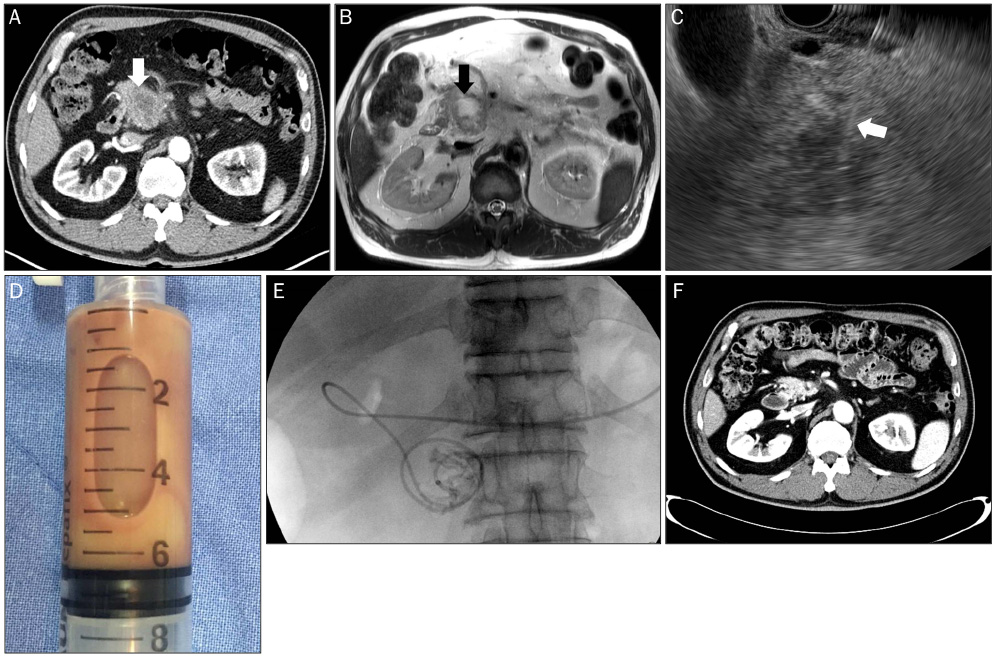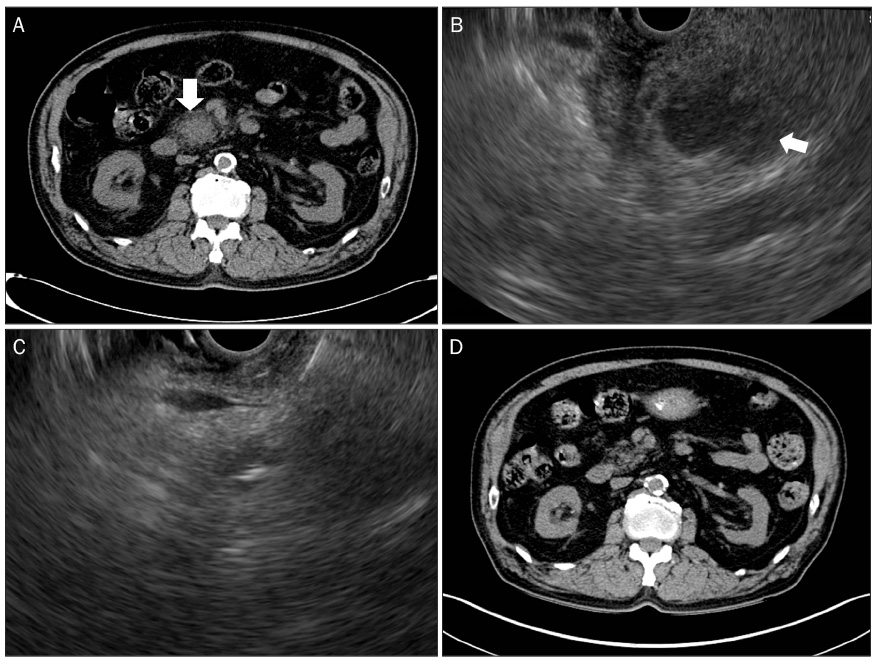Korean J Gastroenterol.
2017 May;69(5):321-324. 10.4166/kjg.2017.69.5.321.
Isolated Pyogenic Pancreatic Abscess Successfully Treated via Endoscopic Ultrasound-guided Drainage
- Affiliations
-
- 1Department of Internal Medicine, Wonkwang University School of Medicine, Iksan, Korea. gipb2592@wku.ac.kr
- KMID: 2383392
- DOI: http://doi.org/10.4166/kjg.2017.69.5.321
Abstract
- An isolated pyogenic pancreatic abscess (IPPA) without pancreatitis is extremely rare but can occur in patients with uncontrolled diabetes. This pathologic condition poses a clinical challenge in diagnosis and management because it can be confused easily with a malignancy. Endoscopic ultrasound (EUS) may be a useful diagnostic modality for indeterminate pancreatic lesions and IPPA. Here, we report two cases with elevated carbohydrate antigen 19-9 levels and pancreatic masses on cross sectional imaging. The patients were subsequently diagnosed with IPPA by EUS. EUS-guided drainage was performed successfully and the patients' clinical symptoms and radiologic findings improved. In our experience, EUS and EUS-guided drainage are crucial steps for the diagnosis and management of patients with an indeterminate pancreatic lesion. In addition, EUS-guided drainage has excellent technical and clinical outcomes for the treatment of IPPA.
Figure
Reference
-
1. Liu Q, He Z, Bie P. Solitary pancreatic tuberculous abscess mimicking pancreatic cystadenocarcinoma: a case report. BMC Gastroenterol. 2003; 3:1.2. Arya M, Arya PK. Pancreatic abscess caused by s. typhi. Indian J Med Microbiol. 2001; 19:18–19.3. Yi SY, Tae JH. Pancreatic abscess following scrub typhus associated with multiorgan failure. World J Gastroenterol. 2007; 13:3523–3525.4. Eliashiv A, Olumide F, Norton L, Eiseman B. Depression of cell-mediated immunity in diabetes. Arch Surg. 1978; 113:1180–1183.5. Peleg AY, Weerarathna T, McCarthy JS, Davis TM. Common infections in diabetes: pathogenesis, management and relationship to glycaemic control. Diabetes Metab Res Rev. 2007; 23:3–13.6. Chong VH. Isolated pyogenic pancreatic abscess mimicking a neoplasm. JOP. 2008; 9:309–312.7. Harewood GC, Wiersema MJ. Endosonography-guided fine needle aspiration biopsy in the evaluation of pancreatic masses. Am J Gastroenterol. 2002; 97:1386–1391.8. Seewald S, Groth S, Omar S, et al. Aggressive endoscopic therapy for pancreatic necrosis and pancreatic abscess: a new safe and effective treatment algorithm (videos). Gastrointest Endosc. 2005; 62:92–100.9. Fernández-del Castillo C, Rattner DW, Makary MA, Mostafavi A, McGrath D, Warshaw AL. Débridement and closed packing for the treatment of necrotizing pancreatitis. Ann Surg. 1998; 228:676–684.10. Kida M, Itoi T. Current status and future perspective of interventional endoscopic ultrasound in Japan. Dig Endosc. 2009; 21:Suppl 1. S50–S52.
- Full Text Links
- Actions
-
Cited
- CITED
-
- Close
- Share
- Similar articles
-
- Could Transgastric Endoscopic Ultrasound-Guided Aspiration Alone Be Effective for the Treatment of Pancreatic Abscesses?
- Endoscopic Ultrasound-Guided Drainage of Pancreatic Fluid Collections (with Video)
- Endoscopic ultrasound-guided drainage for an abscess cavity
- Technical tips for endoscopic ultrasound-guided pancreatic duct access and drainage
- Endoscopic Ultrasound-Guided Treatment beyond Drainage: Hemostasis, Anastomosis, and Others



